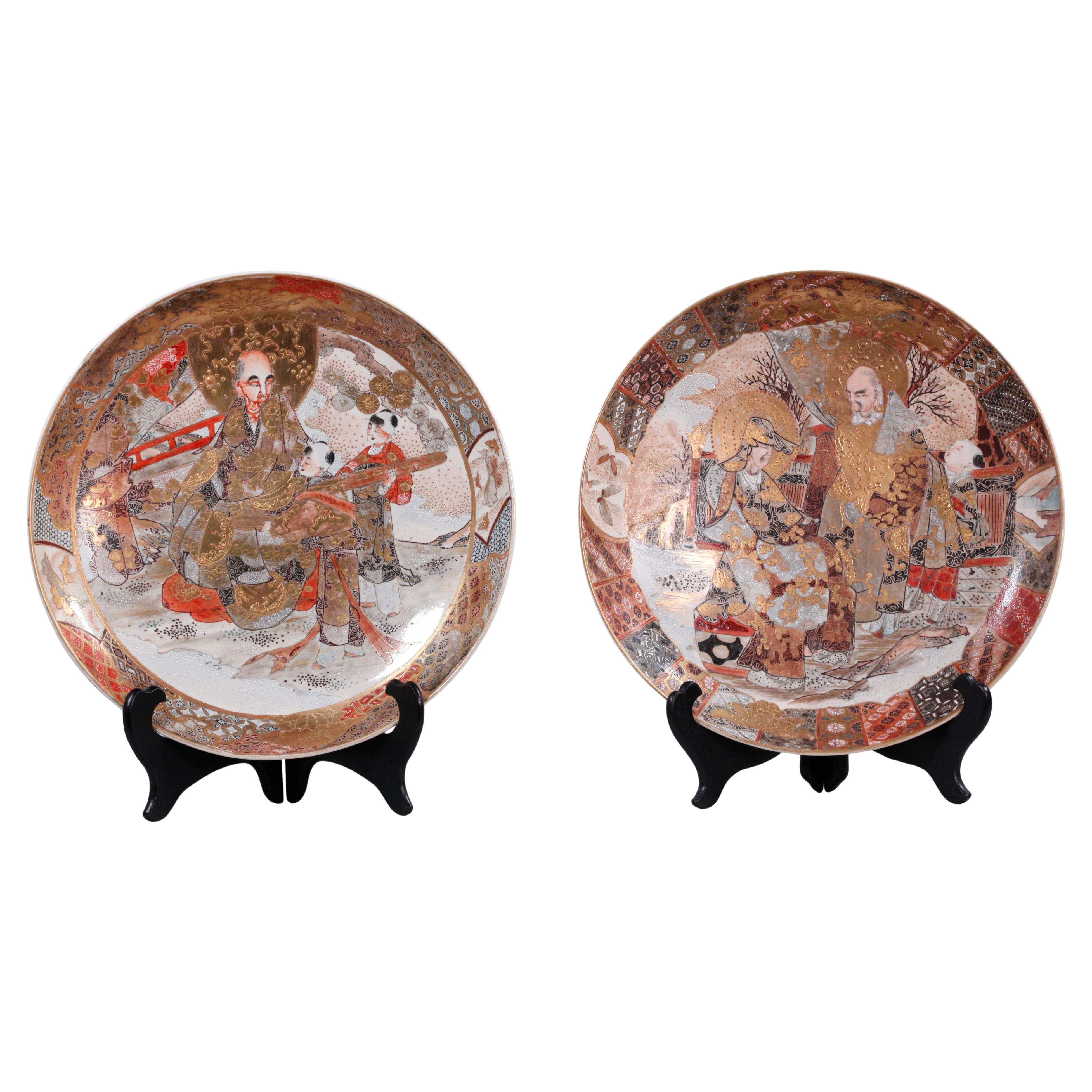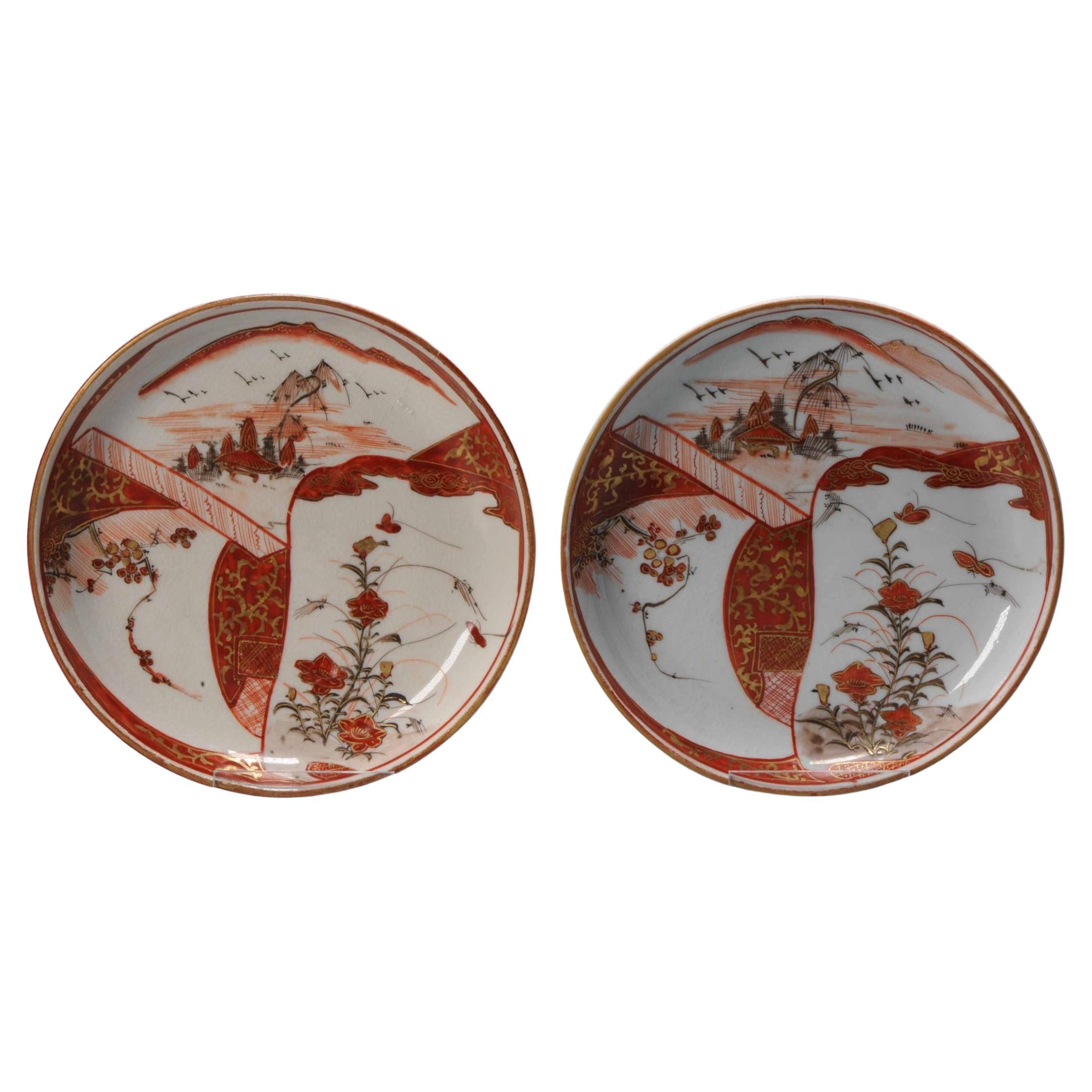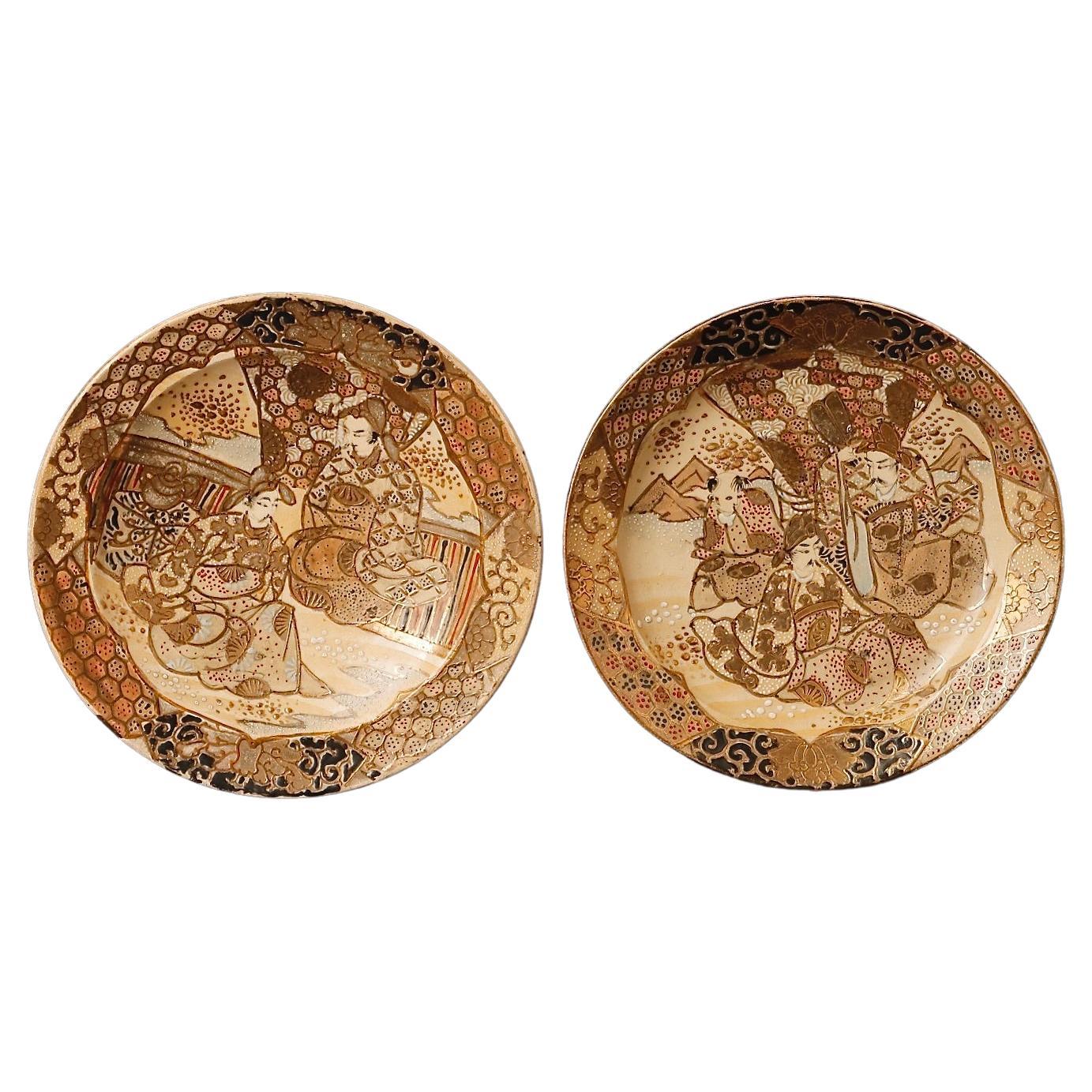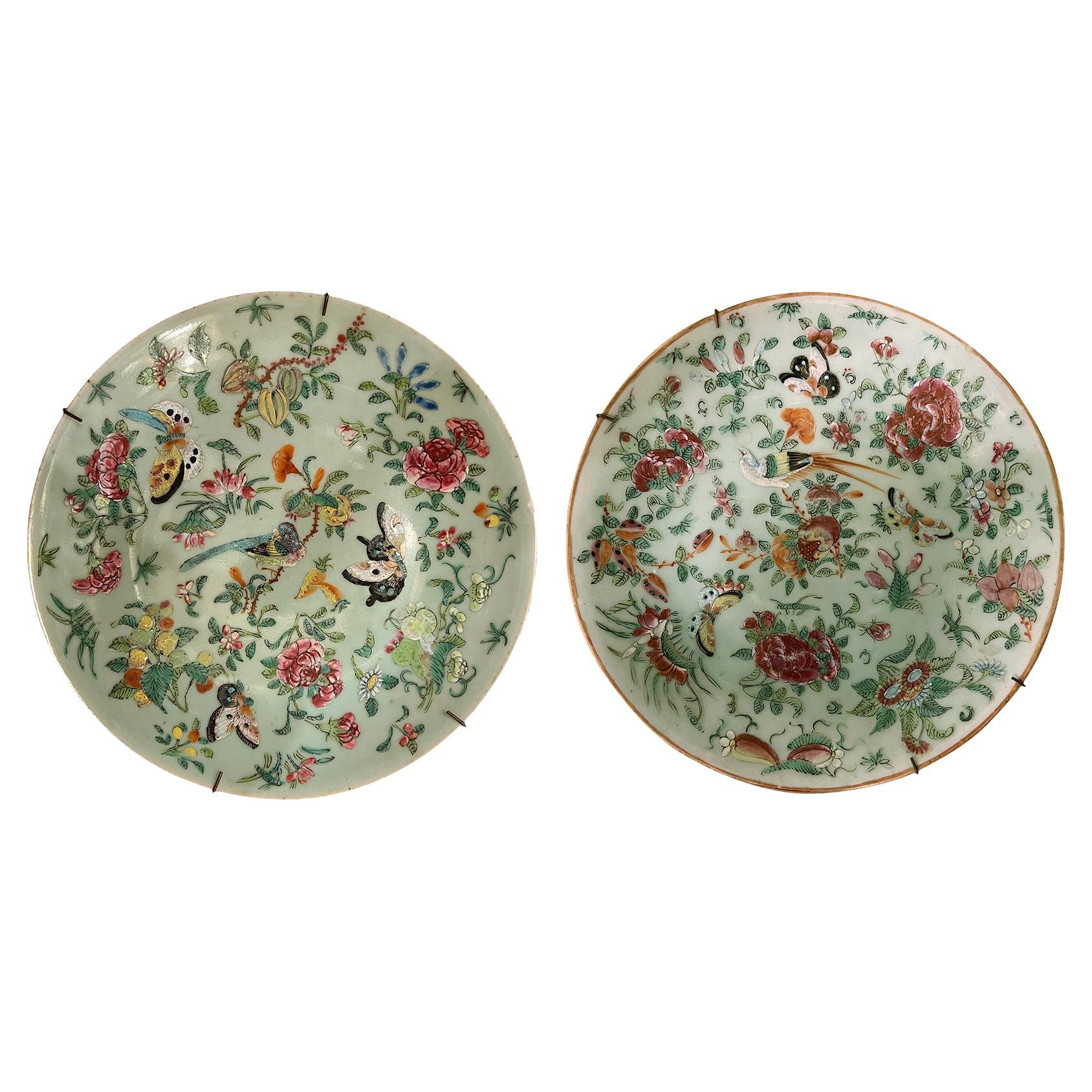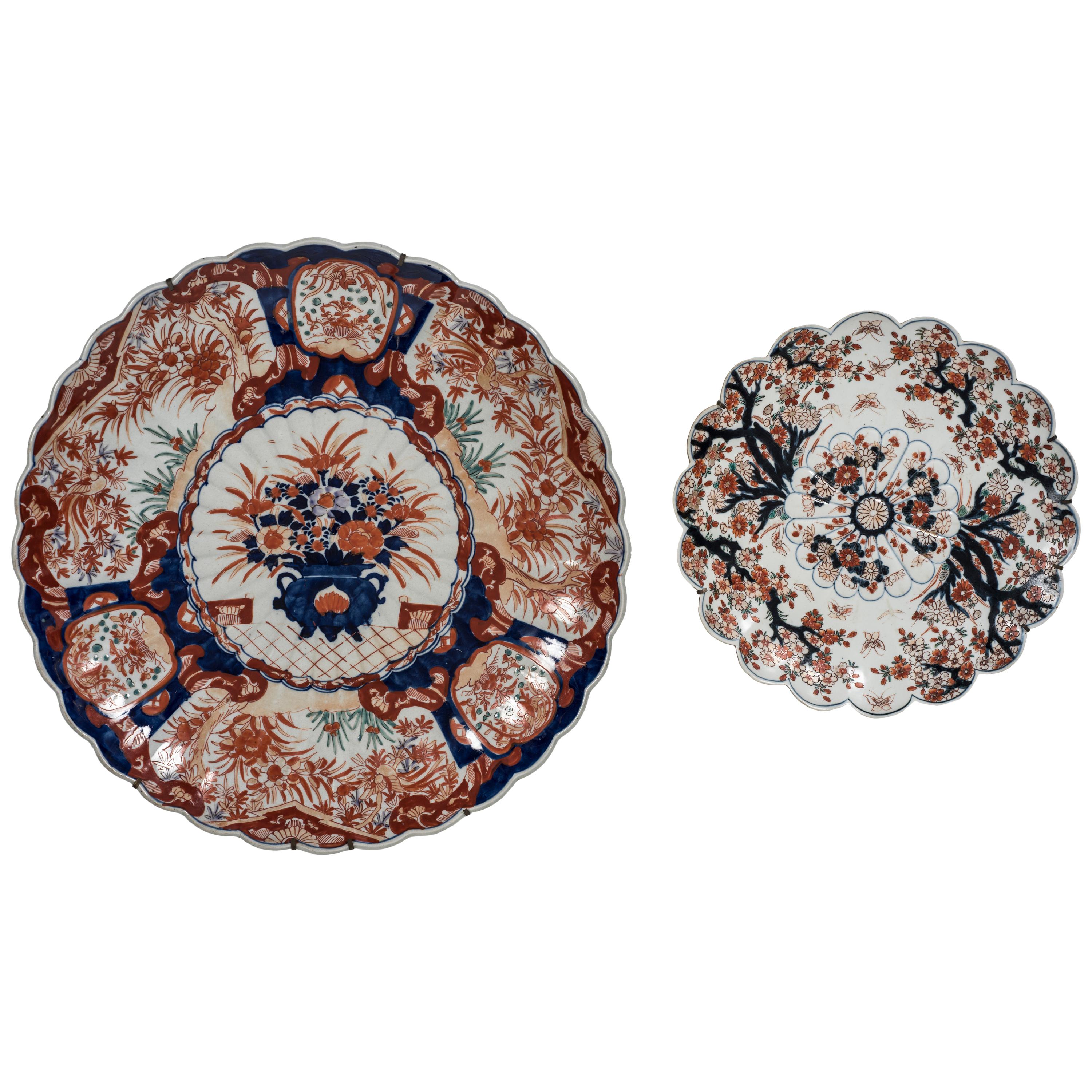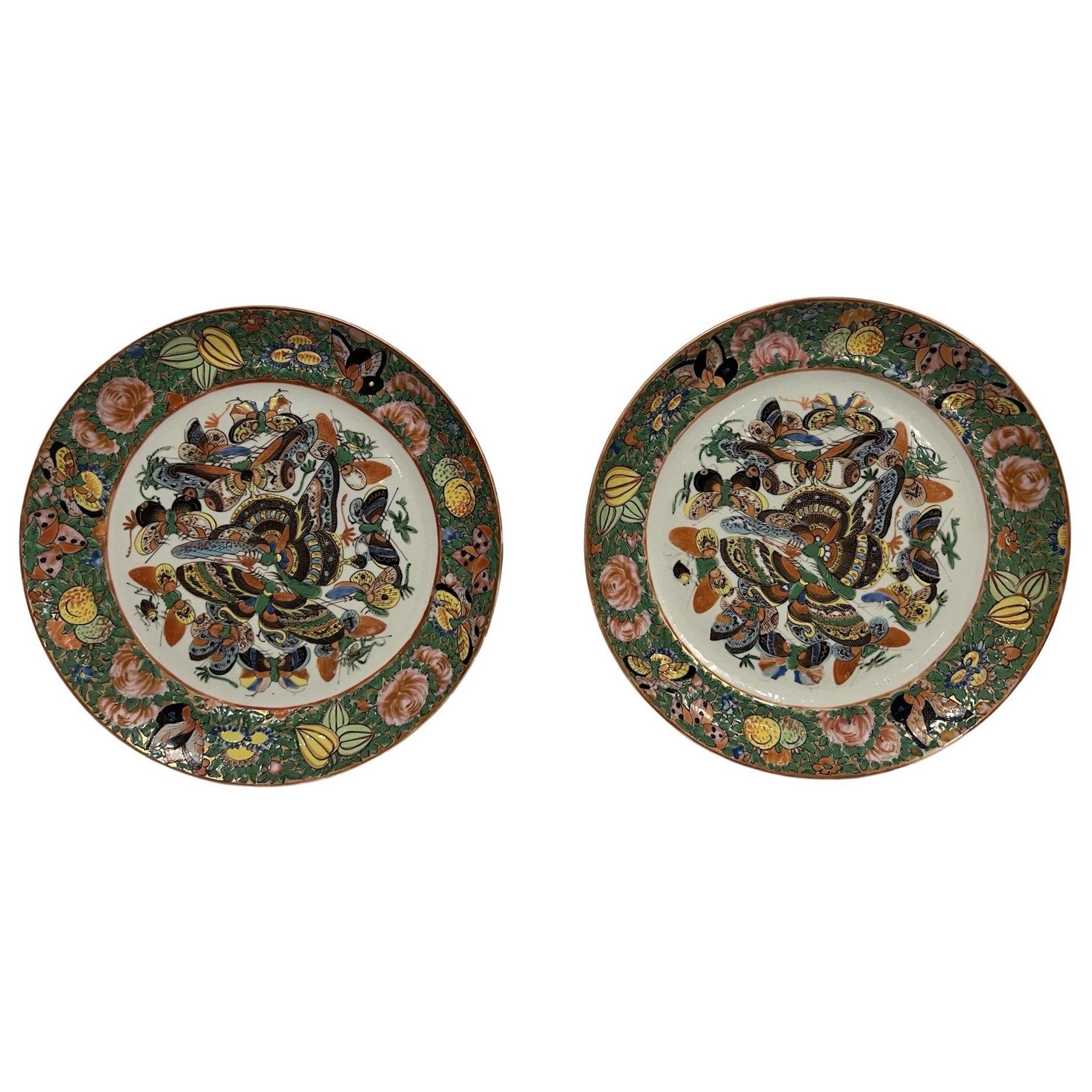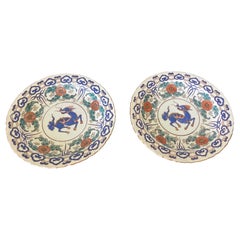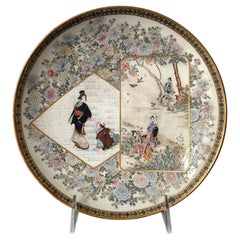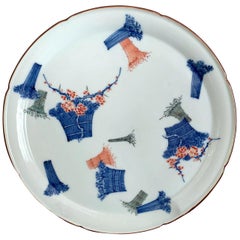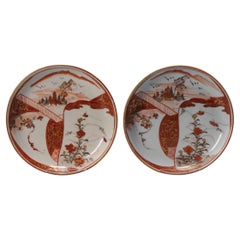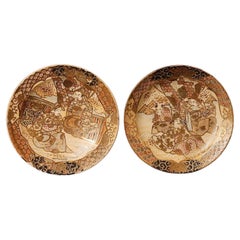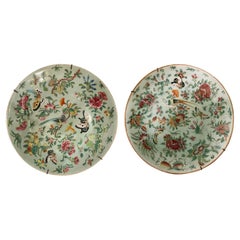Items Similar to Pair Japanese Satsuma Plates with Miniature Decoration by Kinkozan
Want more images or videos?
Request additional images or videos from the seller
1 of 21
Pair Japanese Satsuma Plates with Miniature Decoration by Kinkozan
$4,800per set
£3,669.86per set
€4,226.93per set
CA$6,726.27per set
A$7,509.25per set
CHF 3,934.73per set
MX$91,920.59per set
NOK 49,971.16per set
SEK 47,116.46per set
DKK 31,546.03per set
About the Item
A pair of Satsuma ceramic plates made by Kinkozan studio circa 1880-1900s during the late Meiji Period. Each dish features miniature enamel decoration of two lively festival scenes within a cobalt blue border laced with gold scrolls ornamentation. The parades on each plate showcase two streams of characters going in opposite direction. Each individual, of different gender and age, is realistically painted with unique outfit, face, coiffure and accoutrement they may hold in their hands or carried on their shoulder. There are women in kimono, children holding banners, peasants carrying buckets (perhaps shell games) and actors in theatrical outfit and masks. The harmonious composition provides a snapshot of the life and people in Edo-Meiji time, no different than a photograph in that regards. Under the plate, it was glazed in cobalt blue. Each base is impressed with a four-character seal sign "Kinkozan Tsukuru". The glaze displays an overall even fine crackle. The workmanship is superb and can be catalogized as "miniature art" characterized by the painstaking details, often found in the workshop of Yabu Meizan and Seikozan.
The Kinkozan family established their pottery business first in 1645 and by the end of 19th century, it had become the largest studio producer of Satsuma ware. By the 1850s, Kinkozan Sobei (Kinkozan IV; 1824-84) started to export the wares to the west, particularly to America, together with the Kyoto manufacturer Taizan VIII. This continued and expanded under the leadership of Kinkozan V (1868-1927) until his death in 1927 when the studio closed. Although due to the large output from the studio and target of the markets, the quality varied considerably, Kinkozan did produce some of the best Satsuma pieces from Meiji period.
- Creator:Kinkozan (Maker)
- Dimensions:Height: 0.8 in (2.04 cm)Diameter: 6 in (15.24 cm)
- Sold As:Set of 2
- Style:Meiji (Of the Period)
- Materials and Techniques:Ceramic,Glazed
- Place of Origin:
- Period:
- Date of Manufacture:1890-1900s
- Condition:Wear consistent with age and use. Fine condition with small scattered rubbing off the gilt and enamel on the surface in places. Fine crackling, commensurate with age.
- Seller Location:Atlanta, GA
- Reference Number:1stDibs: LU945034460002
About the Seller
4.9
Platinum Seller
Premium sellers with a 4.7+ rating and 24-hour response times
Established in 2006
1stDibs seller since 2010
565 sales on 1stDibs
Typical response time: <1 hour
- ShippingRetrieving quote...Shipping from: Atlanta, GA
- Return Policy
Authenticity Guarantee
In the unlikely event there’s an issue with an item’s authenticity, contact us within 1 year for a full refund. DetailsMoney-Back Guarantee
If your item is not as described, is damaged in transit, or does not arrive, contact us within 7 days for a full refund. Details24-Hour Cancellation
You have a 24-hour grace period in which to reconsider your purchase, with no questions asked.Vetted Professional Sellers
Our world-class sellers must adhere to strict standards for service and quality, maintaining the integrity of our listings.Price-Match Guarantee
If you find that a seller listed the same item for a lower price elsewhere, we’ll match it.Trusted Global Delivery
Our best-in-class carrier network provides specialized shipping options worldwide, including custom delivery.More From This Seller
View AllPair Antique Japanese Artia Ceramic Cabinet Plates
By Arita
Located in Atlanta, GA
A pair of Japanese decorative ceramic plates, made in Arita for export market circa 17-18th century. The cabinet-display dishes feature lotus-petal gilt rim and a lavish tricolor ene...
Category
Antique 18th Century Japanese Japonisme Ceramics
Materials
Ceramic
Japanese Satsuma Ceramic Dish with Fine Decoration by Kinkozan
By Kinkozan
Located in Atlanta, GA
A satsuma ceramic dish made by Kinkozan studio circa 1980-1900s in the late Meiji Period. The dish with a thick robust wall is supported by a large ring base and features finely deta...
Category
Antique Late 19th Century Japanese Meiji Ceramics
Materials
Ceramic
Fine Japanese Ceramic Plate by Kinkozan for Yamanaka & Co.
By Kinkozan
Located in Atlanta, GA
A fine Japanese ceramic satsuma plate made by Kinkozan and retailed by Yamanaka & Co. circa 1900-20s (late Meiji to early Tasho Period). The cream-color...
Category
Early 20th Century Japanese Meiji Ceramics
Materials
Ceramic
Japanese Antique Kakiemon Plate from Arita
Located in Atlanta, GA
A milky white dish with slight scalloped rim and decorated with cobalt blue iron red and green enamel over glaze, this delicate piece in Kakiemon Style was dated at least to the earl...
Category
Antique Early 18th Century Japanese Japonisme Ceramics
Materials
Porcelain
Fine Japanese Ceramic Plate by Kinkozan for Yamanaka & Co.
By Kinkozan
Located in Atlanta, GA
A fine Japanese ceramic satsuma plate made by Kinkozan and retailed by Yamanaka & Co. circa 1900-20s (late Meiji to early Tasho Period). The cream-color glazed plate features a very fine decoration of a persimmon tree bearing fruits. The composition is poetic, stylized but also realistic, with a literati painter's quality, and was advantageously enhanced by the enamel colorings in incredible details. The mastership of the medium came through the piece. It is signed on the base in gilt kanji seal (Made by Kinkozan) and branded Yamanaka & Co in English. The plate was likely commissioned by the company from Kinkozan for its various galleries in US and Europe.
The Kinkozan family established their pottery business first in 1645 and by the end of 19th century, it had become the largest studio producer of Satsuma ware. By the 1850s, Kinkozan Sobei...
Category
Early 20th Century Japanese Meiji Ceramics
Materials
Ceramic
Fine Japanese Ceramic Plate by Kinkozan for Yamanaka & Co.
By Kinkozan
Located in Atlanta, GA
A fine Japanese ceramic satsuma plate made by Kinkozan and retailed by Yamanaka & Co. circa 1900-20s (late Meiji to early Tasho Period). The cream-color glazed plate features a very fine decoration of a persimmon tree bearing fruits. The composition is poetic, stylized but also realistic, with a literati painter's quality, and was advantageously enhanced by the enamel colorings in incredible details. The mastership of the medium came through the piece. It is signed on the base in gilt kanji seal (Made by Kinkozan) and branded Yamanaka & Co in English. The plate was likely commissioned by the company from Kinkozan for its various galleries in US and Europe.
The Kinkozan family established their pottery business first in 1645 and by the end of 19th century, it had become the largest studio producer of Satsuma ware. By the 1850s, Kinkozan Sobei...
Category
Early 20th Century Japanese Meiji Ceramics
Materials
Ceramic
You May Also Like
Pair of Japanese Satsuma Plates, 19th Century
Located in New York, NY
wooden stands shown in pictures are included with these items; each plate is decorated in gilt and various colored enamels; portraying a scene of enlightened beings; approximate meas...
Category
Antique Late 19th Century Japanese Antiquities
Materials
Porcelain
Pair of Antique Meiji Period Japanese Akae Kutani Plates w/ Flower Mark, 19th C.
Located in Amsterdam, Noord Holland
Faboulous japanese porcelain plate. With box. Mark at the base.
Additional information:
Material: Porcelain & Pottery
Japanese Style: Satsuma
Region of Origin: Japan
Period: 20th ce...
Category
20th Century Japanese Meiji Decorative Dishes and Vide-Poche
Materials
Porcelain
$258 Sale Price
23% Off
Exceptional and rare set of Satsuma porcelain plates Nobles motive, Meiji period
By Satsuma
Located in Fukuoka, JP
Beautiful Satsuma hand-painted porcelain plates set decorated with a motif of Nobles on a picnic. This exceptional set from the Meiji period (19th century) is a fine example of the intricate craftsmanship and attention to detail characteristic of Satsuma ware. Each plate features noble figures in detailed attire, capturing a moment of leisure and refinement.
The Satsuma region, known for its pottery...
Category
Antique Late 19th Century Japanese Meiji Ceramics
Materials
Ceramic
Pair of Porcelain Hand-Painted Decorative Plates
Located in New York, NY
Pair of 19th century Chinese celadon porcelain hand-painted decorative plates.
Measurements:
Diameter: 8.5".
Category
Antique 19th Century Chinese Ceramics
Materials
Porcelain
$1,200 / set
Pair of Ancient Japanese Plates, Japan, 19th Century
Located in Roma, IT
Pair of Japan plates is an original decorative porcelain object realized in the 19th century by Japan manufacture.
The smaller tray is decorated with multicolored floral reliefs and decorations and has a polylobed edge.
On the back, it has decorations painted in blue. Provided with metal base.
Dimensions: Height 4 cm, diameter 32 cm.
The larger tray has a polylobed edge and side panel decorations.
At the center floral decorations and on the back blue decorations with birds and flowers.
It is equipped with a metal wall plate holder...
Category
Antique 19th Century Japanese Platters and Serveware
Materials
Porcelain
$3,473 Sale Price / set
30% Off
Pair, 19th Century Chinese Export "Thousand Butterfly" Porcelain Plates 9.5"
Located in Atlanta, GA
Chinese, early 19th century.
A pair of Chinese export porcelain "Thousand Butterfly" pattern porcelain plates. Each enamel decorated in the famille...
Category
Antique Early 19th Century Chinese Chinese Export Ceramics
Materials
Porcelain
$476 Sale Price / set
20% Off
More Ways To Browse
Japan Gold Plate
Japanese Large Plate
Antique Miniature Plates
Antique Hand Painted Japanese Plates
Japanese Pottery Plate
Lace Plates
Japanese Crackle
Japanese Enamel Plate
Japanese Shell Art
Japanese Cobalt Blue Ceramics
Late Mayers Pottery
Satsuma Pottery
Japanese Satsuma Pottery
Cobalt Blue Gold Plated
Cobalt Gold Plates
Antique Japanese Miniature
Antique American Glaze Pottery
Ceramic Face Plate
